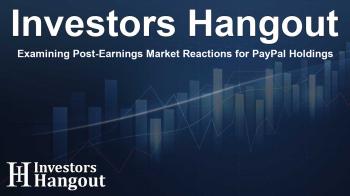Examining Post-Earnings Market Reactions for PayPal Holdings

Understanding the Market Reaction to PayPal’s Earnings
PayPal Holdings (NASDAQ: PYPL) recently faced a notable drop in its stock price after its second-quarter earnings report. This downturn came despite the company surpassing earnings per share and revenue predictions, along with an upward revision of its full-year profit guidance. Investors had anticipated a positive response, but various factors contributed to a wave of skepticism in the market.
Key Metrics from the Earnings Report
In its earnings release, PayPal highlighted several promising metrics. The company achieved an adjusted earnings per share (EPS) of $1.40, exceeding analysts' expectations by $0.09 and exceeding the midpoint of its guidance range of $1.29 to $1.31. Additionally, PayPal reported a Total Payment Volume (TPV) of $443.5 billion, which was approximately 3% higher than market forecasts.
However, the market's negative response can be attributed to a few critical concerns. Management revealed a slowdown in branded checkout TPV growth, which dropped to 5%, compared to 6% in the previous quarter. Furthermore, there was an acknowledgment of a slight softening in U.S. retail spending during the quarter, leading to doubts about the company’s growth trajectory in key areas.
Analyst Insights on PayPal’s Performance
Post-earnings evaluation by Wall Street analysts provided various perspectives on PayPal’s performance. For instance, Patrick Moley from Piper Sandler maintained a neutral stance on the stock, setting a price target of $74. Moley described the earnings beat as solid, highlighting strong transaction margins and a favorable tax rate as contributing factors.
In contrast, Andrew Boone of Citizens JMP Securities reiterated an outperform rating but adjusted his price forecast down from $110 to $100. These mixed reviews indicate a cautious optimism enveloped by some underlying concerns.
Potential Future Developments
Despite the recent stock dip, analysts foresee cautious growth moving forward. Moley noted an upward revision in EPS estimates for both fiscal 2025 and 2026, implying the market may not have fully accounted for the company's growth potential amidst concerns. Management also raised its full-year adjusted EPS guidance to a range between $5.15 and $5.30, suggesting a growth trajectory of approximately 12.5% at the midpoint, which may help alleviate some investor fears.
Venmo, a significant part of PayPal's portfolio, showed promising developments as well, with year-over-year TPV growth of 45% and revenue growth exceeding 20%. This hints at Venmo's importance in PayPal's long-term growth strategy, suggesting that the company is steering toward a robust omnichannel commerce hub.
Investments and Market Confidence
Moley emphasizes that restoring investor confidence will hinge on success in branded checkout services and Venmo's continued growth. However, executing this strategy may necessitate further investments, which could inadvertently pressure margins in the short term.
Comparative Perspectives from Other Analysts
Views on PayPal’s fiscal standing vary widely among analysts, underscoring different assessments of potential growth. Boone's insights indicate a complex landscape where TPV exceeded forecasts, but also showed signs of slowing trends in transaction margin dollars. His sentiment reflects broader apprehensions about achieving the ambitious growth rates suggested previously.
Moreover, despite challenges in meeting high growth targets, Boone remained optimistic about PayPal's innovative product developments. He emphasized the anticipated benefits from improvements in customer experience through new initiatives and the growing adoption of PayPal and Venmo debit cards.
Price Trends Following the Earnings Report
Currently, PayPal's stock is trading slightly down following the earnings report, reinforcing the market's focus on immediate performance metrics rather than long-term potential. At last check, PayPal was lower by 0.46%, trading at about $71.12, demonstrating the market's cautious stance on the stock's outlook amid varying analyst opinions.
Frequently Asked Questions
What caused the decline in PayPal's stock after the earnings report?
The decline is attributed to concerns about slowing growth in branded checkout TPV and a warning of softening U.S. retail spending.
Which analysts provided insights on PayPal’s earnings performance?
Analysts from Piper Sandler and Citizens JMP Securities provided perspectives, with differing stances on PayPal’s stock.
What were the key performance metrics for PayPal in the latest quarter?
PayPal reported an adjusted EPS of $1.40 and a Total Payment Volume of $443.5 billion, which exceeded expectations.
How are Venmo and branded checkout impacting PayPal's growth?
Venmo's strong growth is essential for PayPal’s strategy, while improvements in branded checkout are crucial for restoring investor confidence.
What is the market sentiment on PayPal's future growth prospects?
Market sentiment remains cautious, with some analysts expressing optimism rooted in innovative products while others note potential challenges ahead.
About The Author
Contact Henry Turner privately here. Or send an email with ATTN: Henry Turner as the subject to contact@investorshangout.com.
About Investors Hangout
Investors Hangout is a leading online stock forum for financial discussion and learning, offering a wide range of free tools and resources. It draws in traders of all levels, who exchange market knowledge, investigate trading tactics, and keep an eye on industry developments in real time. Featuring financial articles, stock message boards, quotes, charts, company profiles, and live news updates. Through cooperative learning and a wealth of informational resources, it helps users from novices creating their first portfolios to experts honing their techniques. Join Investors Hangout today: https://investorshangout.com/
The content of this article is based on factual, publicly available information and does not represent legal, financial, or investment advice. Investors Hangout does not offer financial advice, and the author is not a licensed financial advisor. Consult a qualified advisor before making any financial or investment decisions based on this article. This article should not be considered advice to purchase, sell, or hold any securities or other investments. If any of the material provided here is inaccurate, please contact us for corrections.

